From the moment we’re born, our parents have the responsibility to watch over and care for us. For most of the first two decades of our life, their objective is to nourish, cloth and keep us safe and warm. Yet, for a growing number of families, there comes the point when parents need our assistance to manage their physical, mental and emotional needs. Fortunately, there are ample health care options today to help caregivers and their family members determine what type of care is best for each individual.
Almost everyone wants to stay in his or her own home. After all, it’s the place they are most comfortable. Studies show that more than 75 percent of older adults wish to age in their own homes. So in-home care from qualified caregivers – whether a family member, friend or professional – is a preferred option.
But there may come a time when the degree of care or the amount of attention a family member or caregiver is capable of providing exceeds what an aging relative requires. Options such as assisted living facilities, which provide a combination of care while still allowing relative freedom and flexibility, are available in most areas of the country. And when the care needs of an individual exceed both the abilities of their family and the care of assisted living facilities, nursing homes are another option.
Few of us want to think about placing a family member or friend in a nursing home environment. While many nursing home facilities provide high-quality care and attention, negative stories and legal cases of homes providing inadequate care or not properly supervising employees receive the most attention.
To better gauge how Americans feel about nursing homes as a health care option, we analyzed recent Medicare data and surveyed 978 people to get their take on the subject. Take a moment to read through our findings to see how they view nursing homes in America.
According to the Centers for Disease Control and Prevention (CDC), there are approximately 15,600 nursing homes in the United States with 1.7 million licensed beds, occupied by 1.4 million patients. The primary advantage to nursing home care is that patients have access to skilled care 24/7. For some patients, that is vital.
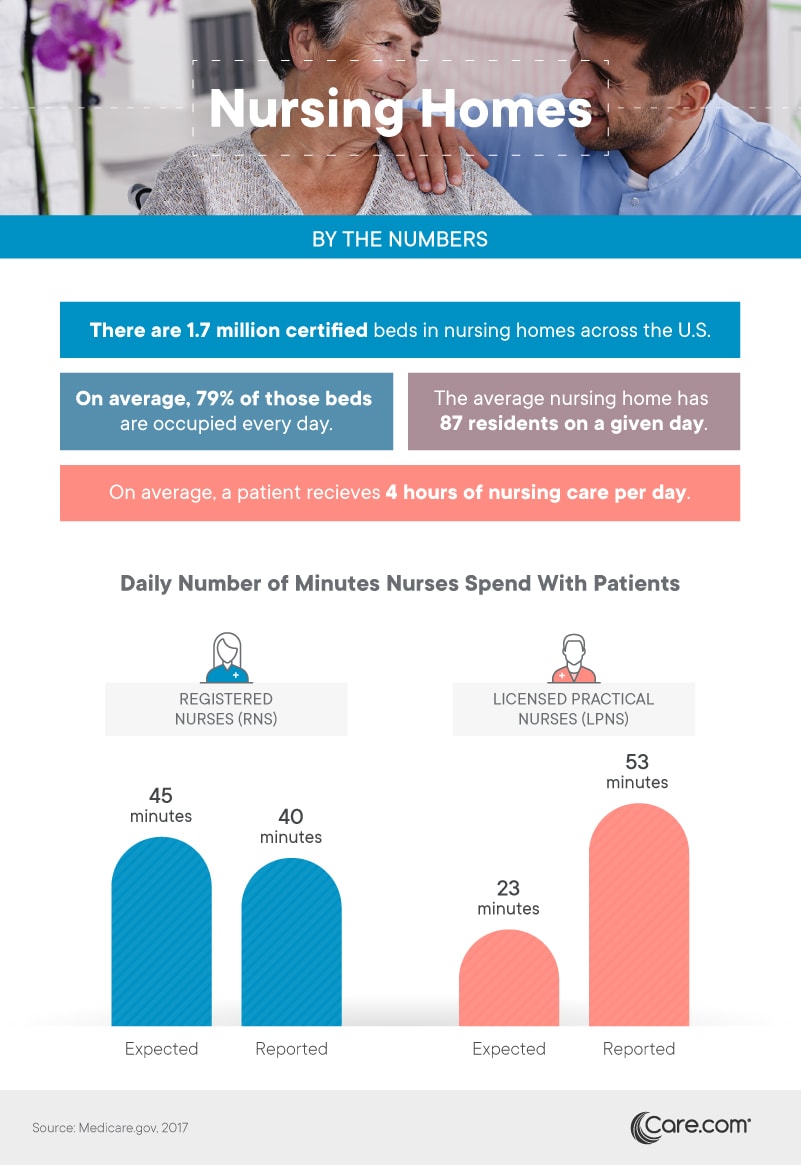
Although nursing homes technically provide care 24 hours a day, seven days a week, that doesn’t mean individuals are supervised continuously. On average, each patient receives about four hours of personalized care per day.
This care comes mainly from two sources: registered nurses (RNs), whose education and training allow them to administer medications and treatments and manage each patient’s care regimen, and licensed practical nurses (LPNs). It’s easy to see how people confuse the two designations. However, there are important differences between RNs and LPNs concerning education and training.
On average, RNs spend about 40 minutes with each patient on a daily basis. LPNs usually spend more time with patients, averaging 53 minutes, since they are responsible for more basic care needs like taking a patient’s blood pressure and temperature and making sure individual patients are comfortable and receiving basic needs.
Not All Nursing Home Care Is Equal
When nursing home care becomes necessary, we would like to believe facilities in every state or community are the same. Unfortunately, like other health care services, that’s not always the case.
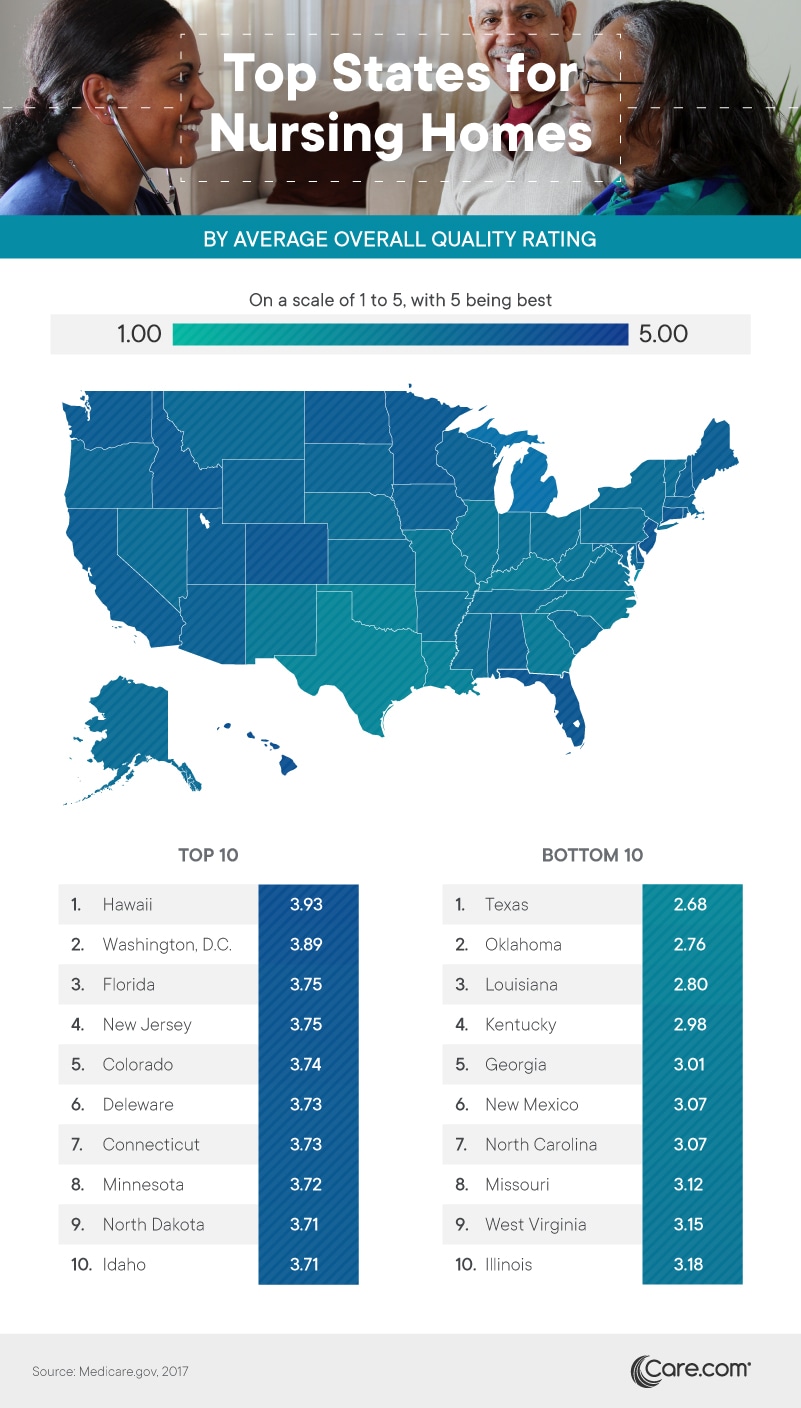
The Centers for Medicare & Medicaid Services (CMS) have created a five-star, quality rating system for nursing homes to help families evaluate how a facility has performed based on the following three areas:
Health Inspections – based on the number, scope and severity of deficiencies identified during the two most recent annual inspection surveys, as well as substantiated findings from complaint investigations.
Staffing – based on two measures, solely related to the nursing staff: registered nurse hours per resident per day and total staffing hours (registered nurse + licensed practical nurse) per resident per day. (Other types of nursing home staff, such as clerical or housekeeping staff, are not included in this rating calculation).
Quality Measures – based on the performance of 16 quality measures: seven for short-term stay residents and nine for long-term stay residents.
The star rating is based on a scale of one to five, with five being a top score. Hawaii received the highest score at 3.93, followed closely by Washington, D.C., Florida, New Jersey and Colorado.
Relatives in Nursing Homes Want You to Visit Longer
Investing quality time to visit with family and close friends is often challenging under the best of circumstances. When it comes to visiting loved ones in nursing homes, many times it’s not as often as they would prefer.
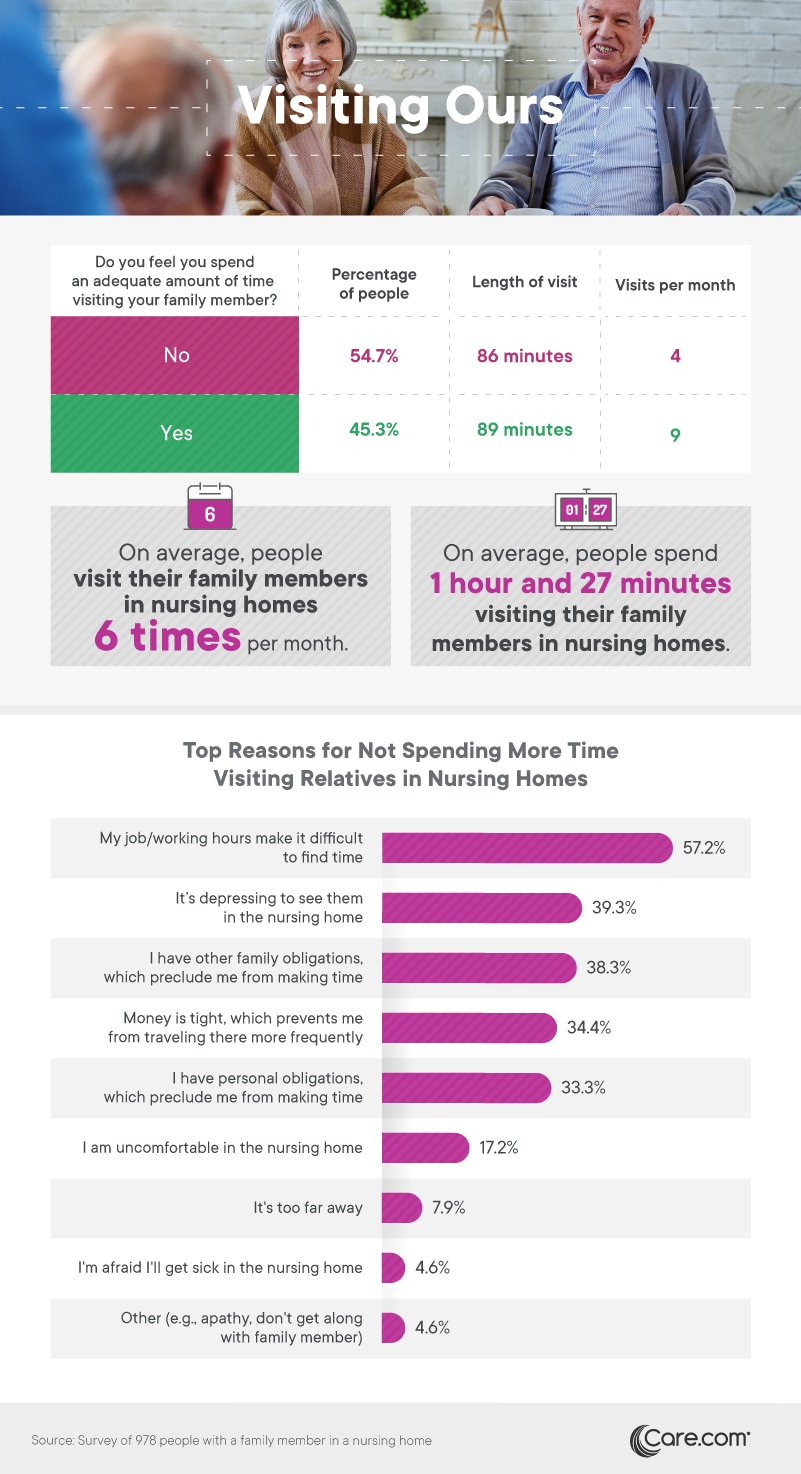
Visiting elders, whether in a nursing home, assisted living facility or even in their own homes, not only brightens their day but also has been shown to benefit their mental and physical health. So how often do people visit loved ones and friends in nursing homes?
According to our survey results, our respondents averaged six nursing home visits per month, staying an average of one hour and 27 minutes per visit.
Well over half (54.7 percent) felt they didn’t spend enough time on nursing home visits, averaging only four trips each month. For the 45.3 percent who were satisfied with their visiting habits, they averaged nine trips each month.
Still, visits were sometimes hard to make. Roughly 57 percent of respondents indicated work issues were the No. 1 culprit for visiting less frequently, and over 39 percent said they found visiting loved ones in the nursing home too depressing. Another 38.3 percent said other family obligations kept them away, with 34.4 percent saying finances or the expense of traveling to the nursing home was a deterrent. Only 7.9 percent gave distance as a reason.
Reasons for Not Visiting Evoke Many Emotions
Regardless of how often family members in nursing homes are visited, loved ones often feel some sense of guilt. An astounding 77.3 percent of our survey respondents felt some type of guilt, so let’s break the numbers down a bit further.
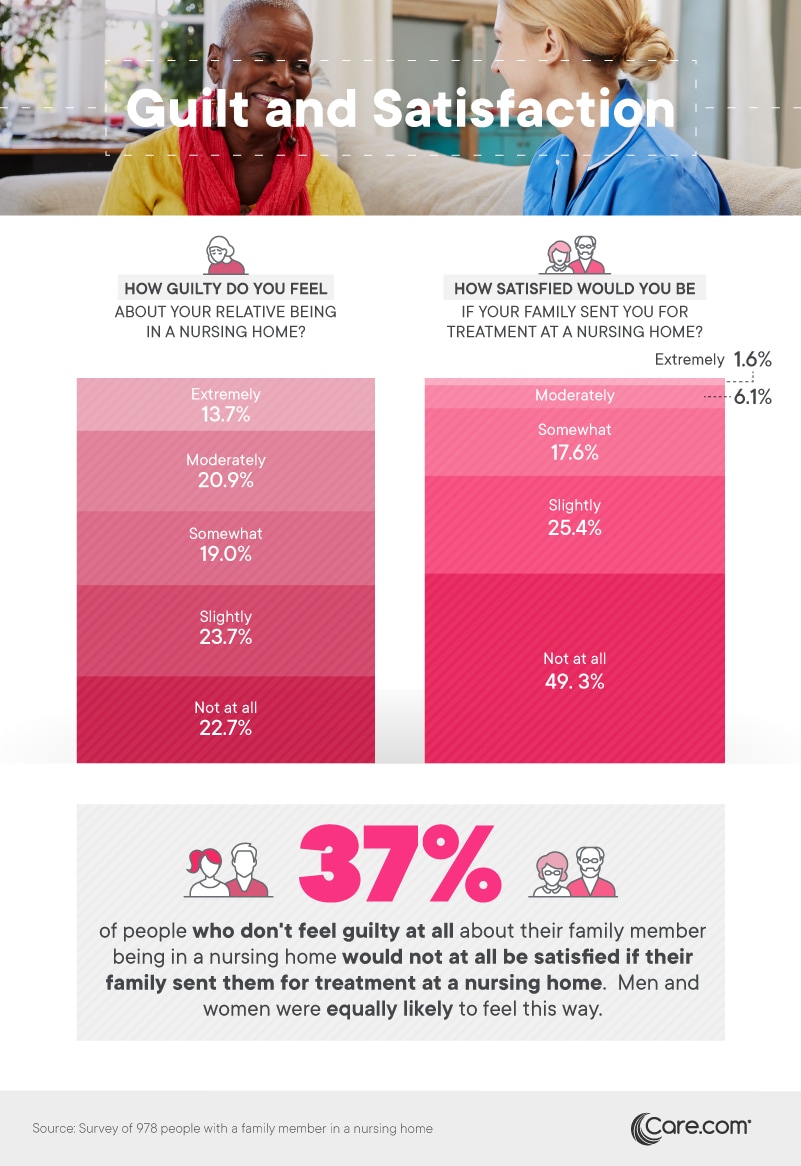
Just under 14 percent reported feeling “extremely” guilt, followed by less than 21 percent who indicated “moderate” guilt about relatives having to live in nursing homes.
Another 19 percent expressed feeling “somewhat” guilty, with those feeling only “slightly” guilty coming in at 23.7 percent. Were any of our respondents guilt-free? Absolutely, because just under 23 percent had a clear conscience about their relative living in a nursing home.
However, experts say feelings of guilt for deciding to place loved ones in a nursing home facility are not unusual.
Regardless of the issues that lead to such a life-changing experience, experts suggest acknowledging such feelings are a normal part of the aging process. They also suggest talking to friends, family or other caregivers may help reduce guilty feelings, especially when you know others are faced with similar decisions.
As expected, when the tables are turned, few of us desire to spend our final days in a nursing home, and it probably comes as no surprise that almost half said they would not be satisfied when that decision was made on their behalf.
Making Difficult, Quality-of-Life Decisions
Nearly three-quarters of respondents to our survey indicated that the decision to send a family member to a nursing home was a difficult one. Experts suggest talking to your aging parents about their care preferences before a crisis erupts, even though research shows many adults would rather have “the sex talk” with their kids than discuss senior care with their parents.
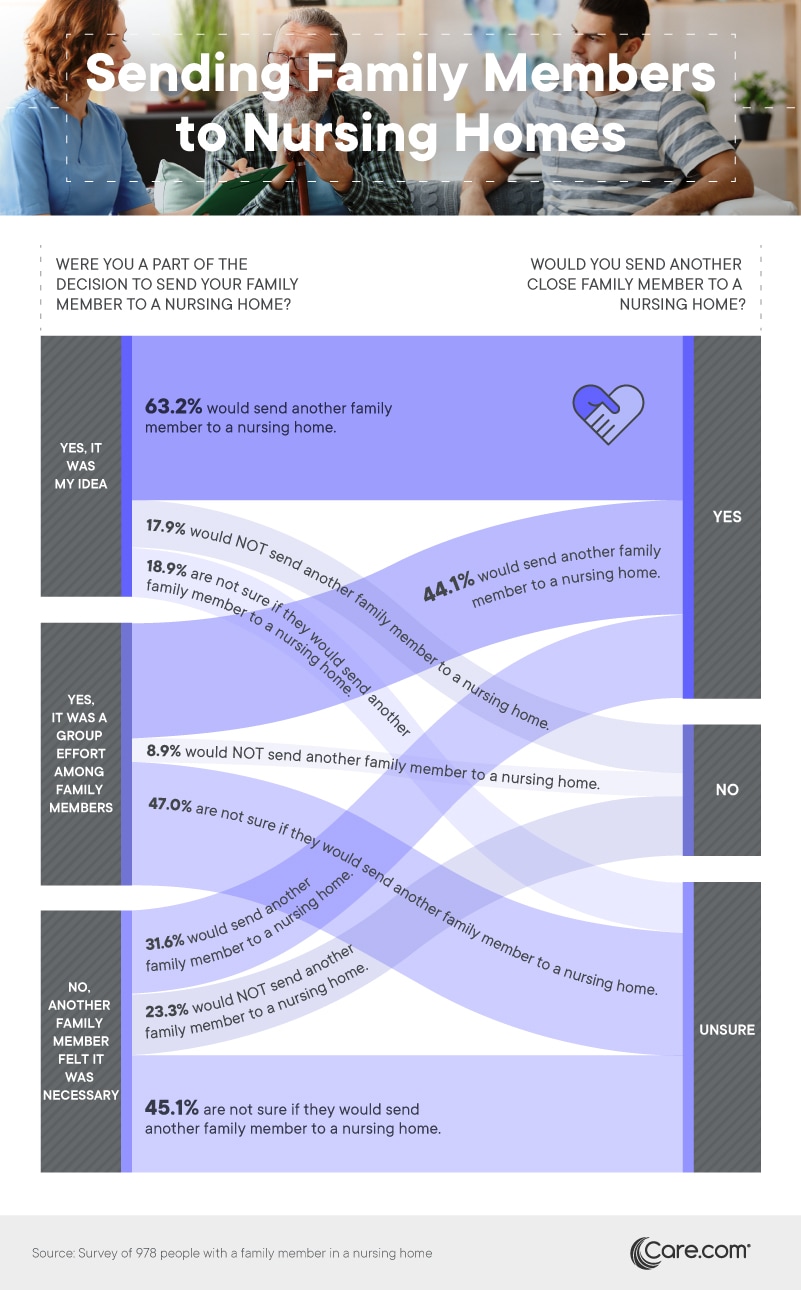
Of the survey respondents who made the final decision alone, 63.2 percent said they would send another aging relative to a nursing home if warranted. However, almost 18 percent said they would not send another aging relative to a nursing home, with nearly 19 percent saying they were unsure of making sure a decision again themselves.
When other family members helped decide if nursing home care was the best option for their relative, the numbers change slightly. Of this group, only 44.1 percent would send another aging relative to a nursing home facility, with another 47 percent expressing their uncertainty.
For our respondents who said another family member decided nursing home care, 45 percent were not sure they would support sending another aging family member to a nursing home.
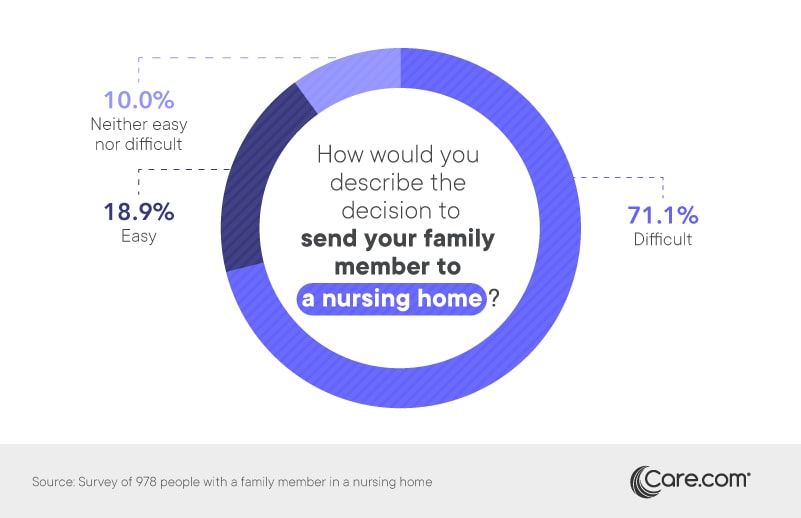
What can families do when an aging parent refuses help? Jody Gastfriend, VP of Senior Care at Care.com and author of My Parents’ Keeper: The Guilt, Grief, Guesswork, and Unexpected Gifts of Caregiving (Yale University Press), suggests working with your parents, as much as possible, and not against them. “We can empathize with their fears and not take their resistance personally,” she writes.

But what if the time comes to tell a family member that nursing home care is best? There are no easy answers —though it can help to talk with other family caregivers who’ve been in a similar position.
Over a quarter of our respondents revealed they gave an aging relative false hope that their stay could be brief or they eventually would be able to return home. That’s most likely not the case for most patients, however, since just under half were admitted from a hospital or other health care facility.
Are Families Satisfied With Nursing Home Care?
Once the decision or health status of an aging family member means nursing home care is in their future, relatives obviously want the best care and facilities their resources can provide. The question is: Are they satisfied with their relative’s nursing home?
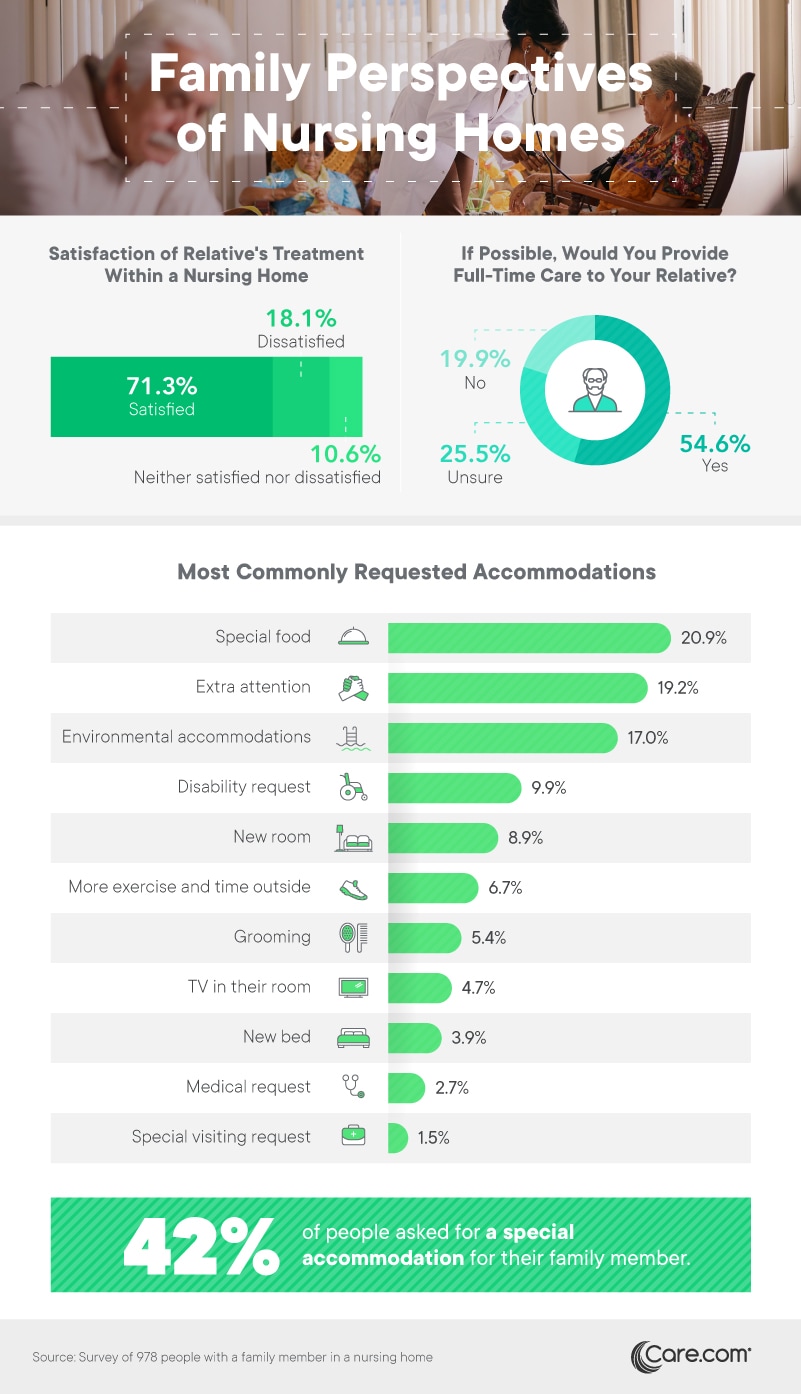
Over 71 percent of those surveyed said they were satisfied with the care their aging relative received in a nursing home. Another 18.1 percent were dissatisfied, with 10.6 percent being neither.
Because people in nursing homes require more skilled care, they tend to receive a higher level of medical attention compared to those in assisted living facilities or those receiving in-home care. Other benefits are 24-hour supervision, meal services and assistance with strenuous activities.
Over half of those surveyed said they would provide full-time care to an aging relative if possible, but another 25.5 percent were unsure.
Another area we surveyed concerned the most common requests made during a relative’s nursing home stay. Topping the list was requesting special food items at just over 20 percent, followed by extra attention at 19.2 percent and environmental accommodations (e.g., room temperature) at 17 percent.
Finally, 42 percent of respondents said they asked for some type of special accommodation to make their loved one’s stay more pleasant.
The State of Acute vs. Chronic Stays
Our high school health or science class taught us the difference between acute (mild and less severe) and chronic (sometimes more severe and lasting longer than six months) pain. According to recent data compiled by Medicaid, on average, nursing home residents with short-term stays tend to experience more pain compared to fellow residents with more extended stays.
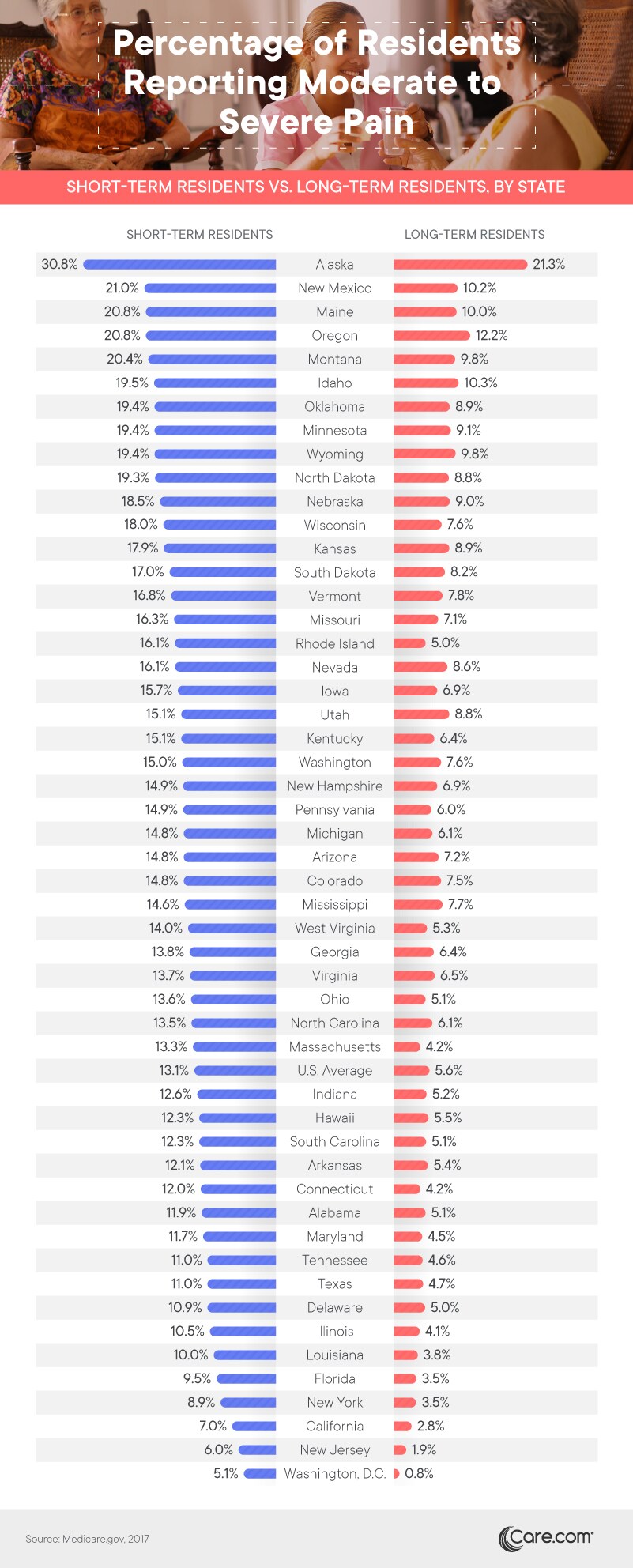
The national average of long-term patients self-reporting moderate to severe pain was 5.6 percent, while the average for short-term patients is more than twice that, at 13.1 percent.
The Medicaid study reported just under 31 percent of short-term nursing home residents in Alaska self-reported moderate to severe pain – the most of any state.
Supporting Caregivers and Aging Relatives Is Our Goal
Most of us can agree that skilled or nursing home care should be a last resort for everyone, regardless of age. After all, most people want to stay in the comfort of their homes as long as possible.
Many factors contribute to deciding that skilled care is the best option for everyone. Family members and engaged friends, along with medical professionals and especially the family member or loved one requiring a high level of care, are all important when it comes to making such a critical, quality-of-life decision.
That’s why those of us at Care.com are here to provide as much information and support as needed. After all, our mission is to improve the lives of families and caregivers by helping them connect reliably and easily, especially when it comes to finding the right caregiver for your family.
Methodology and Limitations
We analyzed and visualized Nursing Home Compare data for 2017, provided by the Centers for Medicare & Medicaid Services, to provide insight into the state of nursing homes in the U.S. The information on Nursing Home Compare comes from three key sources: the Centers for Medicare & Medicaid Services’ (CMS) health inspection database, a national database of resident clinical data known as the Minimum Data Set (MDS) and Medicare claims data. Additionally, we surveyed 978 Americans with a family member who was currently seeking treatment in a nursing home facility. Of the survey respondents, 54.8 percent were female and 45.1 percent were male, with the remaining 0.1 percent not listing their self-identified gender. The average age of respondents was 37.6 years old with a standard deviation of 11.8. As with any survey that utilizes self-reported data, there are potential issues with the data collected. These issues include, but are not limited to: selective memory, telescoping, attribution and exaggeration.
Sources
- https://www.webmd.com/health-insurance/nursing-home-care#1
- https://www.cdc.gov/nchs/fastats/nursing-home-care.htm
- https://www.allnursingschools.com/articles/registered-nurse-vs-licensed-practical-nurse/
- https://www.cms.gov/medicare/provider-enrollment-and-certification/certificationandcomplianc/fsqrs.html
- https://www.worldatlas.com/articles/the-us-states-with-the-oldest-population.html
- https://www.telegraph.co.uk/lifestyle/wellbeing/11812307/Mixing-young-and-old-people-can-extend-lives.html
- https://www.psychologytoday.com/us/blog/understanding-grief/201705/guilt-and-grief-placing-loved-one-in-nursing-facility
- https://www.verywellhealth.com/how-to-decide-if-its-time-for-nursing-home-care-98182
- https://www.care.com/c/questions/3267/how-do-i-tell-someone-they-are-moving-permane/
- https://www.longtermcarelink.net/eldercare/nursing_home.htm
- https://www.nic.org/blog/key-takeaways-from-the-second-quarter-2018-nic-skilled-nursing-data-report/
- https://www.nytimes.com/2018/09/28/health/nursing-homes-occupancy.html
- https://www.nia.nih.gov/health/residential-facilities-assisted-living-and-nursing-homes
- https://my.clevelandclinic.org/health/articles/12051-acute-vs-chronic-pain
- https://www.apmhealth.com/news-updates/apm-blog/item/121-whats-the-connection-between-the-weather-and-pain-levels
- https://www.ncbi.nlm.nih.gov/pmc/articles/PMC5435509/
- https://dailycaring.com/3-ways-to-support-seniors-during-a-short-term-nursing-home-stay/
- https://www.care.com/what-we-do
Fair Use Statement
Are you or another family member or friend considering a nursing home for a loved one? If so, and you feel the information from this article could help ease their worry, feel free to share the graphics and content for noncommercial purposes. Just make sure to link back to this page so that those who compiled and reported these data receive proper credit.



